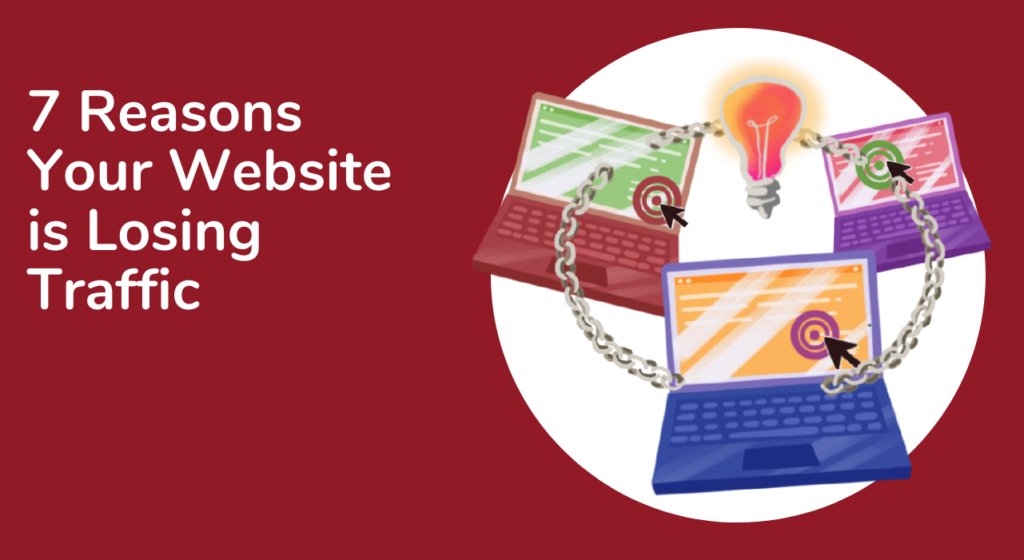The Top 7 Causes of Website Traffic Drops

Nothing hurts more than checking your Google Analytics account and seeing a massive drop in traffic over the past few months. If you’ve been investing time and money in high-quality content, you may feel at a loss, unable to figure out why traffic has been decreasing. Here are the seven main reasons webmasters experience sudden and gradual traffic drops.
1. Algorithm Updates
Algorithm updates are frequently the cause of sudden traffic drops. We’ve all heard of major updates like Panda and Penguin, but minor updates can wreak havoc on your rankings as well.
Major updates like Penguin, Panda, and Hummingbird changed the algorithm entirely. They targeted spam and manipulative rankings tactics like keyword stuffing, link farming, and low-quality content, including spun and duplicate content.
Many websites experienced major traffic drops after those updates. Sites that used mass link building, for example, suddenly went from the front page of Google to the back burner when algorithms targeting such practices were released.
However, Google updates its algorithm thousands of times a year. Most of those changes are minor and have no discernible impact on most sites. Not all updates are broad core algorithm updates. However, some changes, while not big enough to make the news, can still cause your site to drop in rankings and lose traffic.
Some updates will only impact certain sites or pages, like local businesses and product review pages.
2. Black Hat Practices and Penalties
People often experience traffic losses after using black hat SEO practices. These practices violate Google’s guidelines and try to manipulate Google into thinking your site offers more value than it truly does.
Sometimes, Google’s algorithms will automatically detect that something is up, and your site will gradually lose rankings as a result. This typically happens after algorithm updates, when Google gets better at detecting black hat practices and old tactics suddenly stop working.
However, Google also sometimes gives out manual penalties. These penalties are human-reviewed and not determined by an algorithm. When you get a manual penalty, you might not just lose rankings, but your site might get crossed off Google entirely.
When you get de-indexed from Google, you will lose almost all of your organic search engine traffic, retaining only the traffic from alternative search engines like Bing.
Before I continue, I’d like to point out another issue that can be causing you to lose traffic. It’s not always obvious at first, and it might not be your fault at all: The black hat tactics might not be something you did yourself.
Competitors may conduct malicious targeting campaigns to try to lower your rankings. For example, they might pay someone to set up link farms to try to make Google think that it was you who used black hat techniques.
Monitoring your backlink profile regularly is the best antidote to this, as it allows you to detect malicious links early on before you receive any penalties from Google. You’ll be able to request for the links to be removed. If they are not, you can disavow them using Google’s Disavow Tool, so Google knows that you didn’t create those links.
3. Rank Loss
Rank loss can occur for a few reasons. While Google algorithm updates, black hat tactics, and manual penalties can be factors, rank loss is a lot broader than that.
New competition can often be a factor. Brand-new websites frequently have a harder time going against more established websites, but that’s not always the case. Besides, competitors who have already been blogging for a while might suddenly start targeting the same keywords you do, and their established domain authority can help them outrank you quickly.
Another cause for rank loss can be a loss of backlinks. Backlinks and local link building are critical for achieving high rankings. However, what many people don’t think about is maintaining those backlinks to keep your rankings.
You can lose your links for a few reasons. Sometimes, the sites or pages linking to you go offline. The webmaster might abandon the site entirely, take down a specific page, or simply redirect to a new page and forget to link to you from that one.
People might also remove links pointing to your site during manual audits. If they determine that your page no longer offers accurate, up-to-date information, they might replace your link with a link to another site. That’s why updating your pages often is critical. It’s also worth conducting a backlink and local citation audit.
Broken redirects can be another cause of rank loss. It’s essential to make sure your redirects are working. Sometimes, if you change the URL of a webpage, you can lose rankings too. Avoid editing a URL after a page has been indexed unless absolutely necessary.
Site structure changes can also cause pages to lose rank, so make sure you submit an updated sitemap to Google.
A change in user behavior when using the search engines can also trigger rank loss. If you are getting a lower CTR on Google, which can happen after editing your meta description and title, Google may start demoting you in the results. Use Google Search Console to track your CTR rate.
4. Seasonality of Content, Products, and Services
Traffic drops aren’t always due to something you did wrong. Sometimes, a keyword, product, blog post topic, or service falls from popularity. Just because something was trending a few months ago, doesn’t mean it will continue trending forever.
That’s why writing evergreen content is so critical. Chasing trends can work for the short term, but writing content that will always attract traffic is a much better strategy for the long term.
In the same vein, seasons can affect traffic patterns. A simple example would be writing a blog post about Easter treasure hunt ideas or Easter recipes. Around Easter, you’ll get a lot of traffic, but you probably won’t get much traffic the rest of the year.
If you write a blog post about vehicle maintenance tips during the winter, you’ll get a lot of hits for only half the year or so. Writing seasonal content is sometimes appropriate, but don’t be surprised if traffic drops when the season ends.
5. Significant Website Changes
Significant website changes can cause you to start losing traffic. Things like changing your theme, redirecting pages, and migrating to a new domain name are all things that can trigger ranking and traffic drops. The way you reorganize your website, whether you add new categories, and whether pages are recategorized can also make a difference.
Editing and updating large batches of content can also cause you to lose traffic for a while. You might delete some keywords that were bringing in large numbers of visitors, and Google will need some time to adjust to your changes and get you ranking for new keywords and content.
That’s why it’s critical to restructure your site with the help of someone who fully understands SEO.
Sometimes, a change in web design can cause your bounce rate to go up. If the changes make your site harder to navigate, people will be more likely to bounce off your site instead of visiting other pages. They will also be likely to spend less time on the page they land on.
Time spent on page and bounce rates may affect SEO, as they are indicators of how interesting and informative your site is.
6. Technical Errors
There are a lot of technical errors that can cause traffic drops. Mentioned already were redirects that weren’t set up properly, but broken outbound links can also hurt your rankings as well. Make sure you are only linking to updated sites, and use a tool to check for broken links on your site, so you can replace them quickly.
Broken Link Checker is a free tool you can use to audit your site for broken links.
Widgets that don’t appear properly and images that don’t load can also cause a drop in traffic and rankings. Some other things worth paying attention to are mobile responsiveness and site speed.
Both of those factors are critical for SEO. Installing a new plugin, adding a new contact form or popup, and uploading a video can all have a negative impact on both site speed and mobile responsiveness.
Continual testing is critical. Google has free tools, called PageSpeed Insights and the Mobile-Friendly Test tool, to help you figure out which issues on your site might be hurting you.
7. Website Navigation Problems
Website navigation issues are another reason people start losing traffic. Usually, they lead to a gradual decline in the number of people linking to and visiting your site.
A poorly-designed menu that makes it hard to find what you’re looking for is a common website navigation problem. If menu links don’t work, whether in the main or secondary menu, it will make your site look unprofessional and not up-to-date. If you recently updated your website menu, ensure it is easy to navigate on both desktop and mobile.
Final Thoughts
A sudden drop in traffic can be scary, but it’s usually due to one of the above seven reasons. Oftentimes, getting your traffic volume numbers back is as simple as figuring out what caused the loss and remedying the issue.
Interested in Updating Your Website?
Contact us to learn more about our design & development services and other methods we use to grow our clients’ brands online.
